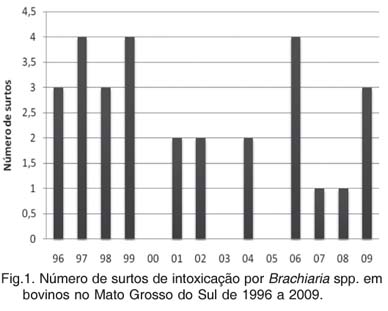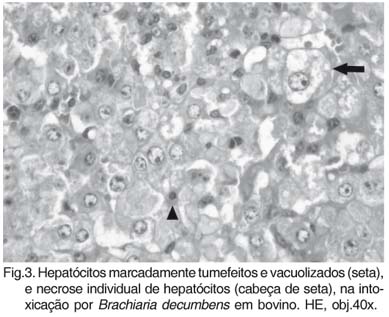The epidemiology, clinical signs and pathology of 29 outbreaks of spontaneous poisoning by Brachiaria spp. in beef cattle, which occurred from March 1996 to November 2009, in the state of Mato Grosso do Sul, were retrospectively studied. For this, the files of the Veterinary Pathology Laboratory at the Federal University of Mato Grosso do Sul were reviewed. Outbreaks occurred at different times of the year, including dry and rainy seasons. While photosensitization was the main clinical sign in cattle from 24 out of 29 outbreaks, in five of them the main clinical sign was progressive wasting, without photosensitization. Eleven outbreaks of photosensitization occurred in pastures of Brachiaria decumbens, two in mixed pastures of B. decumbens and B. brizantha, and one in B. brizantha. In 10 outbreaks the species of Brachiaria was not informed. Morbidity ranged from 0.2% to 50%, and fatality rates were between 44.4% and 100%. In cases of photosensitization brisket edema was the most frequent clinical sign observed. Dermatitis with thickened skin of the flank and perineal region, scar retraction of the ears, jaundice, ocular discharge, crusts in the eyes and ears, and ulceration of the ventral surface of the tongue were also observed. Nervous signs were observed in two cases and diarrhea in one. At necropsy the liver was enlarged, yellowish, with increased lobular pattern, and occasionally with depressed whitish areas. The kidneys were brownish and the urine dark. Upon histological examination of the liver the hepatocytes were swollen and vacuolized. Individual necrosis of hepatocytes, bile duct cell proliferation, biliary retention, and mild to moderate periportal fibrosis were also observed. In all cases foamy macrophages, most in groups, were observed mainly in the centrilobular region. In 21 cattle birefringent crystals were observed within the bile ducts. Five outbreaks of progressive wasting were observed in cattle grazing B. decumbens pastures. The main lesion was an enlarged yellowish liver. Histologic lesions were similar to those observed in cases of photosensitization. Birefringent crystals were observed in the liver of three cases, but foamy macrophages were found in all animals. It is concluded that B. decumbens is more toxic than B. brizantha and that the poisoning occurs at any time of the year. Nevertheless, research is still necessary to determine variations in the saponin content of Brachiaria species and the probable differences on susceptibility/resistance to the poisoning of cattle of different ages, breeds and from different regions.
Brachiaria spp.; Brachiaria decumbens; poisonous plants; photosensitization; progressive wasting; ruminants; plant poisoning





